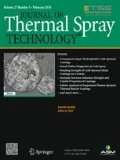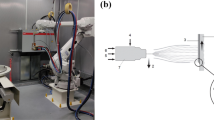Abstract
When describing the cold-spray process, one of the most widely used concepts is the critical velocity. Current models predicting critical velocities take the temperature of the sprayed particles explicitly into account, but not the surface temperature (substrate or already deposited layers) on which the particle impacts. This surface temperature is expected to play an important role, since the deformation process leading to particle bonding and coating formation takes place both on the particle and the substrate side. The aim of this work is to investigate the effect of the substrate temperature on the coating formation process. Experiments were performed using aluminum, zinc, and tin powders as coating materials. These materials have a rather large difference in critical velocities that gives the possibility to cover a broad range of deposition velocity to critical velocity ratio using commercial low-pressure cold-spray system. The sample surface was heated and the temperature was varied from room temperature to a high fraction of the melting point of the coating material for all three materials. The change in temperature of the substrate during the deposition process was measured by means of a high speed IR camera. The coating formation was investigated as a function of (1) the measured surface temperature of the substrate during deposition, (2) the gun transverse speed, and (3) the particle velocity. Both single particle impact samples and thick coatings were produced and characterized. Both the particle-substrate and interparticle bonding were evaluated by scanning electron microscopy (SEM) and confocal microscopy.














Similar content being viewed by others
References
Dykhuizen, R.C. et al., Impact of high velocity cold spray particles. J. Therm. Spray Technol., 1999. 8(4): p. 559–564
F. Gartner, et al., Numerical and Microstructural Investigations of the Bonding Mechanisms in Cold Spraying, ITSC 2003: International Thermal Spray Conference, ASM International, 2003
Assadi, H. et al., Bonding Mechanism in Cold Gas Spraying. Acta Mater., 2003, 51(15): p. 4379–4394
J.H. Lee, et al., Effect of Particle Temperature on the Critical Velocity for Particle Deposition by Kinetic Spraying, ITSC2006: International Thermal Spray Conference, Seattle, 2006
Jodoin B., F. Raletz, and M. Vardelle, Cold Spray Modeling and Validation Using an Optical Diagnostic Method. Surf. Coat. Technol., 2006, 200 (14-15): p. 4424–4432
Jodoin, B., Cold Spray Nozzle Mach Number Limitation. J. Therm. Spray Technol., 2002, 11(4): p. 496–507
Schmidt, T., et al., Development of a Generalized Parameter Window for Cold Spray Deposition. Acta Mater., 2006, 54(3): p. 729–742
F. Gartner, et al., The Cold Spray Process and Its Potential for Industrial Applications, J. Therm. Spray Technol., 2006, 15(2), p. 223–232
Schmidt T., F. Gaertner, and H. Kreye, New Developments in Cold Spray Based on Higher Gas and Particle Temperatures. J. Therm. Spray Technol., 2006, 15(4): p. 488–494
Author information
Authors and Affiliations
Corresponding author
Additional information
This article is an invited paper selected from presentations at the 2007 International Thermal Spray Conference and has been expanded from the original presentation. It is simultaneously published in Global Coating Solutions, Proceedings of the 2007 International Thermal Spray Conference, Beijing, China, May 14-16, 2007, Basil R. Marple, Margaret M. Hyland, Yuk-Chiu Lau, Chang-Jiu Li, Rogerio S. Lima, and Ghislain Montavon, Ed., ASM International, Materials Park, OH, 2007.
Rights and permissions
About this article
Cite this article
Legoux, J.G., Irissou, E. & Moreau, C. Effect of Substrate Temperature on the Formation Mechanism of Cold-Sprayed Aluminum, Zinc and Tin Coatings. J Therm Spray Tech 16, 619–626 (2007). https://doi.org/10.1007/s11666-007-9091-y
Received:
Revised:
Accepted:
Published:
Issue Date:
DOI: https://doi.org/10.1007/s11666-007-9091-y




